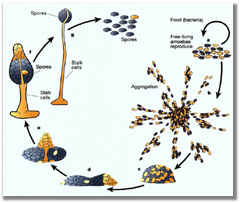 |
|
|
 |
||
|
||||||||
|
Frontiers in Integrative Biological Research (FIBR) 2003 awards "The Evolution of Biological Social Systems"
|
||||||||
|
September 2003 A slime-mold crowd of single-celled amoebas seems an unlikely place to look for the origins of complex social traits - especially altruism, where one individual risks itself for the benefit of an unrelated other. But, through an NSF Frontiers in Integrative Biological Research project, that's where David Queller and Joan Strassmann of Rice University and colleagues from the Baylor College of Medicine are looking, with good and complex reasons. Biologically, cooperation, even sacrifice, among cells is more apparent in multi-cellular organisms, where cells have specific roles. For example, some transmit impulses, some pump gases, some produce the sperm or eggs that carry forth inherited characteristics, and some protect those that have the primary roles of reproduction. But how do genetically unrelated single-celled amoebas distribute their roles when times get hard? When a slime mold faces starvation, unrelated amoebas form a fruiting body, shaped like a balloon on a string, with only those cells at the top able to form reproductive spores for dispersal, while others literally in supporting roles forego an opportunity to pass on their genes. Using genetic technology and the sequenced genome, the FIBR group will seek to identify the genes and molecular pathways that underlie this form of social behavior among amoebas. The researchers will also examine the evolutionary costs of "cheating" (by clones whose cells avoid contributing to the sterile stalk). Though mechanisms for social behavior in slime molds may not correspond closely to those in other organisms, this project is among the first to examine social evolution at such detail. Lead principal investigators (Rice University): Participating institutions: Media contact at Rice: Jade Boyd, (713) 348-6778, jadeboyd@rice.edu Total funding (est.), through August 2008: $5 million Helpful web sites: http://www.ruf.rice.edu/~evolve http://www.ruf.rice.edu/~evolve/study.html#Dicty Award abstract: https://www.fastlane.nsf.gov/servlet/showaward?award=0328455 The FIBR projects announced today include the following: |
Larger versions (Total Size: 583KB) of all images from this document |
|
The National Science Foundation (NSF) is an independent federal agency that supports fundamental research and education across all fields of science and engineering, with an annual budget of nearly $5.3 billion. NSF funds reach all 50 states through grants to nearly 2,000 universities and institutions. Each year, NSF receives about 30,000 competitive requests for funding, and makes about 10,000 new funding awards. The NSF also awards over $200 million in professional and service contracts yearly.
Receive official NSF news electronically through the e-mail delivery system, NSFnews. To subscribe, send an e-mail message to join-nsfnews@lists.nsf.gov. In the body of the message, type "subscribe nsfnews" and then type your name. (Ex.: "subscribe nsfnews John Smith")
Useful NSF Web Sites:
NSF Home Page: http://www.nsf.gov
News Highlights: http://www.nsf.gov/od/lpa
Newsroom: http://www.nsf.gov/od/lpa/news/media/start.htm
Science Statistics: http://www.nsf.gov/sbe/srs/stats.htm
Awards Searches: http://www.fastlane.nsf.gov/a6/A6Start.htm
|
|


